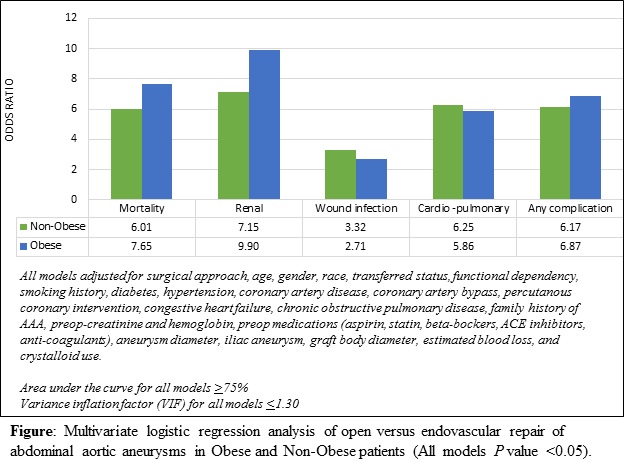Outcomes following Elective Abdominal Aortic Aneurysm Repair in Obese Versus Non-Obese Patients.
Satinderjit Locham, MD, Muhammad Rizwan, MD, Besma Nejim, MD, Hanaa Dakour Aridi, MD, Muhammad Faateh, MD, Mahmoud Malas, MD, MHS.
Johns Hopkins Medical Institution, Baltimore, MD, USA.
OBJECTIVES: Obesity is a worldwide epidemic, particularly in the Western society. It predisposes surgical patients to an increased risk of adverse outcomes. The aim of our study is to use a nationally representative vascular database and compare in-hospital outcomes in obese versus non-obese patients undergoing elective open (OAR) and endovascular (EVAR) aneurysm repair. METHODS: All patients undergoing elective AAA repair were identified in Vascular Quality Initiative (VQI) database (2003-2017). Obesity was defined as body mass index > 30 kg/m2. Univariate and multivariate analyses were implemented to examine in-hospital mortality and any major complications (wound infection, renal and cardio-pulmonary failure). RESULTS: We identified a total of 33,284 patients undergoing OAR (N=6,359) and EVAR (N=26,723). Of which, 28% and 31% patients were obese in OAR and EVAR, respectively. Compared to non-obese patients, obese patients were relatively younger (68 vs. 70 years and 71 vs. 75 years) and had slightly longer operative time [259.02 vs. 239.37 and 138.27 vs. 134.34 minutes] and higher blood loss [2,030 vs. 1,619 and 228 vs. 207 milliliters] in both OAR and EVAR, respectively (All P<0.001). No difference was seen in mortality between the two groups undergoing OAR (2.9% vs. 3.2%) and EVAR (0.5% vs. 0.6%) (Both P>0.05). After adjusting, obese patients undergoing OAR had 33% higher risk of renal failure (adjusted OR (95%CI): 1.33(1.09-1.63), P=0.006) and 75% higher risk of wound infections (adjusted OR (95%CI): 1.75(1.11-2.76), P=0.02). However, no difference was seen in any-major complications in patients undergoing EVAR. Moreover, OAR was associated with nearly six to eight fold increase risk of mortality in both obese and non-obese patients (figure). All major in-hospital complications were also significantly higher following OAR versus EVAR in both groups. CONCLUSIONS:
We demonstrated an increased risk of renal failure and wound infections in obese patients undergoing OAR compared to non-obese patients. Furthermore, OAR demonstrated an increased risk of in-hospital mortality and all major complications compared to EVAR in both groups. The magnitude of majority of these complications following OAR versus EVAR was higher in obese patients. We further recommend the utilization of EVAR in obese patients. 
Back to 2018 ePosters




